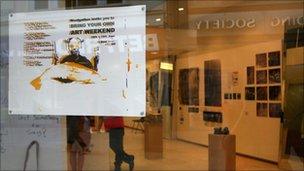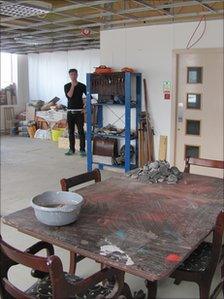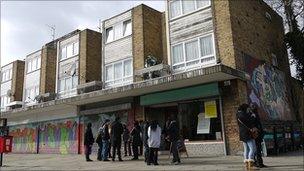Empty shops become art galleries
- Published
Last weekend, shoppers popping into the Gregg's bakery or the Pret a Manger on one of the busiest streets in Leeds may have noticed something strange going on next door.

The "bring your own art" exhibition in Leeds attracted more than 80 artists. Photo: Annie Nelson
Instead of the shell left over from the clothes store at 31 Bond Street, which went bust in 2009, they would have found the shop filled with paintings, drawings, photographs and live art.
There was a sculpture of a toothbrush with human hair instead of bristles and the walls were crowded with canvases and prints.
Three children had been cajoled into becoming a mini-art movement and were drawing portraits on demand. A home-made ping-pong table constructed from an old cupboard was part installation, part entertainment.
This was a bring your own art show, open to all-comers - a DIY answer to the Royal Academy Summer Exhibition.
More than 80 eager art-makers turned up to put their work in this pop-up gallery. Organised by the Woolgather art collective, the quality was variable but the artists could show off their work in a location they would normally only dream of.
They are not the only artists to take advantage of the empty shops and offices that have spread like a plague on the country's high streets since the recession.
Almost one in 10 stores in the UK are vacant, according to a recent survey by property consultants Colliers International.
In Leeds, arts, theatre and film-making groups have turned this in their favour by occupying around 18 vacant commercial properties.

A solicitors' office in Newcastle has been transformed into artists' studios
Old office blocks are used for photo displays, students' exhibitions and life drawing classes, while there is a temporary film set in a disused 7,000 square foot warehouse.
That will not give much comfort to those who used to work there, but for the artists, it is an unexpected bonus of the credit crunch.
Ken Stratford, operations manager at Leeds-based East Street Arts, which runs the units, says the artists would not have otherwise had access to such large, well-located and cheap spaces.
"The premises are being used for public benefit, we're brightening up areas that are standing empty and helping to change the image, and we get the resource that we can give artists to use," he says.
And the artists' occupations are entirely legal.
Most landlords pay full business rates on properties that have been empty for more than three months. But if they let them to charities, they get 80% off.
So it pays to allow arts organisations like East Street Arts, which is a charity, to house-sit until new commercial tenants can be found.
In Newcastle, a condemned, non-descript five-storey former solicitors' office block in the city centre has been commandeered by artists for use as studios. There will be 65 when the building is full.
Inside, the managers' cubicles have been occupied by fine artists, while the open-plan areas are littered with sculptural debris and half-finished large-scale creations.

Artists recently occupied an empty shop in Kilburn, north London. Photo: Dan Thompson
Swathes of the generic blue carpet squares have been ripped up, the bog-standard white ceiling tiles displaced, and the building's past is further obscured by the jumbles of tools, electrical equipment, books and materials scattered around the floor.
Artists in the NewBridge Project pay £15 a week for a studio. The project has also set up a ground floor gallery in an old housing association office.
The initiative is run by Will Marshall and Will Strong, two Newcastle University fine art graduates, who say it has helped the local creative culture by allowing more graduates to stay in the city.
"One of the unique things about Newcastle is that there is this wealth of empty space," Will Strong says.
"There is a wealth of huge business premises slap-bang in the city centre that you can do very interesting projects from, rather than just being these scars on the city."
Arts Council England allocated £500,000 to 24 empty shops projects in 2009, and says it continues to fund others, including the NewBridge Project. The number of empty shops and offices used by artists is clearly a tiny proportion of the total, though.
Artist Dan Thompson, who heads the Empty Shops Network, has been colonising unused units for a decade and advises like-minded creators on how to do the same thing.
"People are fed up of empty shops, they are fed up of units that sit there doing nothing," he says. "They'd rather see them doing something creative and fun rather than just being empty."
The number of artists moving into the high street is "going up and up all the time", he believes. "When we started 10 years ago there were a few people who did it here and there. Now it feels like every town has got something going on."
Thompson has transformed languishing shops in Shoreham-by-Sea, West Sussex, and Kilburn, north London.
His next project, The Ministry of Littlehampton, will see children from 11 local schools compiling an alternative guide to the West Sussex town.
Calling himself a "social artist", he quotes the Turner Prize-winner Jeremy Deller when defining an artist's role: "It's about making things happen, rather than making things."
Shops are better than traditional galleries, he says, because they are less intimidating for visitors and easier to exhibit in for artists.
"Because it's low cost and it's often temporary, it gives you a chance to be bold and try things that you might not try otherwise," he adds. "It gives you a chance to experiment."
And local communities and businesses benefit because artists spruce up their shops and bring in a new crowd, he explains.
"We've done up the shop front, we've re-planted all the planters in the precinct," he says of the Kilburn project. "It looks better now than it did before we came. So everybody wins."
The Woolgather exhibition at 31 Bond Street, Leeds, will re-open from Thursday to Saturday from 1200 to 1800 BST.
- Published17 May 2011
- Published17 May 2011
- Published9 September 2010